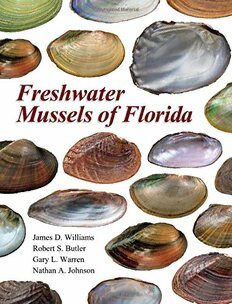
Freshwater Mussels of Florida PDF
Preview Freshwater Mussels of Florida
Freshwater Mussels of Florida Freshwater Mussels of Florida James D. Williams, Robert S. Butler, Gary L. Warren, and Nathan A. Johnson With special thanks to Sherry L. Bostick Richard T. Bryant Sponsored by Florida Fish and Wildlife Conservation Commission The University of Alabama Press / Tuscaloosa Copyright © 2014 The University of Alabama Press Tuscaloosa, Alabama 35487-0380 All rights reserved Printed in Korea ∞ The paper on which this book is printed meets the minimum requirements of American National Standard for Information Sciences—Permanence of Paper for Printed Library Materials, ANSI Z39.48-1984. Library of Congress Cataloging-in-Publication Data Williams, James D. (James David), 1941– Freshwater mussels of Florida / James D. Williams, Robert S. Butler, Gary L. Warren, and Nathan A. Johnson. pages cm Includes bibliographical references and index. ISBN 978-0-8173-1847-5 (hardcover : alk. paper) — ISBN 978-0-8173-8779-2 (e book) 1. Freshwater mussels—Florida. I. Title. QL430.6.W553 2014 639’.4209759—dc23 2013040134 Publication made possible in part by generous contributions from the Florida Fish and Wildlife Conservation Commission; the Florida Department of Environmental Protection; the Institute of Food and Agricultural Sciences, University of Florida, Gainesville; the Jacksonville Shell Club, Florida; the U.S. Fish and Wildlife Service, Region 4 Office, Atlanta, Georgia; and the U.S. Geological Survey, Southeast Ecological Science Center, Gainesville, Florida. We take great pleasure in dedicating this book to Thompson H. Van Hyning (1861–1948) and William H. Heard (1935–) in recognition of their significant contribution to our understanding of the freshwater mussel diversity of Florida over the past century. CoNteNtS Preface ..........................................................................................................................ix Acknowledgments .......................................................................................................xi Abbreviations ............................................................................................................xvii List of Bivalve Mollusk taxa ....................................................................................xix Chapter 1. Introduction ...............................................................................................1 Chapter 2. History of Mussel exploration .................................................................5 Chapter 3. Geology and Physiographic Divisions ...................................................23 Chapter 4. Inland Waters ..........................................................................................34 Chapter 5. Mussel Distribution .................................................................................59 Chapter 6. Biology and ecology ................................................................................72 Chapter 7. Mussel Conservation ...............................................................................94 Chapter 8. Shell Morphology and Soft Anatomy ..................................................113 Chapter 9. Format of Accounts for Genera and Species ......................................125 Chapter 10. Accounts for Genera and Species ......................................................129 Genus Alasmidonta .............................................................................................131 Genus Amblema ..................................................................................................138 Genus Anodonta .................................................................................................147 Genus Anodontoides ...........................................................................................163 Genus Elliptio .....................................................................................................168 Genus Elliptoideus .............................................................................................221 Genus Fusconaia ................................................................................................227 Genus Glebula ....................................................................................................237 Genus Hamiota ...................................................................................................242 Genus Lampsilis .................................................................................................252 Genus Medionidus ..............................................................................................266 Genus Megalonaias ............................................................................................281 Genus Obovaria ..................................................................................................286 Genus Plectomerus .............................................................................................294 Genus Pleurobema .............................................................................................298 Genus Ptychobranchus .......................................................................................308 Genus Pyganodon ...............................................................................................313 Genus Quadrula .................................................................................................318 Genus Reginaia ..................................................................................................330 Genus Toxolasma ................................................................................................337 Genus Uniomerus ...............................................................................................349 Genus Utterbackia ..............................................................................................360 Genus Villosa ......................................................................................................373 viii Contents Chapter 11. Species of Hypothetical occurrence ..................................................395 Margaritifera marrianae ....................................................................................395 Elliptio nigella ....................................................................................................396 Lampsilis binominata .........................................................................................397 Lasmigona subviridis ..........................................................................................398 Pyganodon cataracta ..........................................................................................400 Chapter 12. Additional Bivalves in Inland Waters ................................................402 Family Cyrenidae – Marshclams ........................................................................403 Family Dreissenidae – Falsemussels...................................................................405 Family Mactridae – Surfclams ............................................................................408 Family Sphaeriidae – Fingernailclams, Peaclams, and Pillclams .......................409 Key to the Additional Bivalves in Inland Waters ................................................416 Glossary ....................................................................................................................419 Literature Cited ........................................................................................................433 General Index ...........................................................................................................475 Systematic Index ......................................................................................................487 Preface Just a half century ago, there were fewer than a dozen individuals in the United States actively conducting research on freshwater mussels. With passage of the federal Endangered Species Act (ESA) in 1973, interest in the plight of mussels and other non- game aquatic organisms in the United States began to build. It was soon realized that as many as 30 mussel species were extinct and many more were declining at an alarming rate. This wave of extinction and decline ignited efforts by malacologists and university, state, and federal aquatic biologists to compile mussel lists for various drainages, iden- tify habitat threats, and evaluate conservation status for North American taxa. Publica- tion of Unionacean Clams of North America by Jack B. Burch in 1975 represented a monumental step forward in the effort to document the U.S. mussel fauna. This was the first widely available comprehensive work on North American freshwater mussels that included a key to species. Today there are books addressing the mussel faunas of many states in the eastern United States (e.g., Parmalee and Bogan 1998; Williams et al. 2008). Investigation of the Florida mussel fauna began in the early 1800s by naturalists liv- ing in the northeastern United States. In the 1800s Isaac Lea, a conchologist from Phila- delphia, Pennsylvania, described 18 nominal taxa from Florida based on shells that he obtained from other mollusk collectors. In the late 1800s and early 1900s, father and son naturalists Samuel H. Wright and Berlin H. Wright, who lived in New York, described 33 nominal species of Florida mussels. Charles T. Simpson of the U.S. National Mu- seum of Natural History (USNM), Smithsonian Institution, also described new species from Florida but more importantly provided an early critique of previous work. Interest in Florida mussels waned from the early 1900s to the mid-1950s. Renewed interest came from a 1950s mollusk survey in the Gulf Coast rivers of Alabama, Florida, and Georgia by William J. Clench and Ruth D. Turner from the Museum of Comparative Zoology (MCZ) at Harvard University. During the 1960s and 1970s, Richard I. Johnson, also from the MCZ, produced several publications on mussels in Florida and adjacent states. The Identification Manual of the Freshwater Clams of Florida was published by William H. Heard (1979a) of Florida State University. This work represented the first statewide treatment of a mussel fauna in the southeastern United States and heralded the beginning of renewed interest in Florida mussels. The Florida mussel fauna is con- siderably less diverse than those of Alabama and Georgia. However, Florida’s relatively lower species diversity is offset by extraordinary levels of variation in shell morphol- ogy. This morphological diversity and difficulty in species delineation continues to be a challenge. The Florida land mass experienced dramatic changes during the Pleistocene Epoch, and the present-day fauna, especially in the peninsular region, is geologically young. The fact that Florida is adjacent to inland areas with higher molluscan diversity, has both Gulf and Atlantic Coast rivers, and a variety of aquatic habitats unparalleled in the southeastern United States provides an interesting setting for the study of mussel biology, ecology, and evolution.
